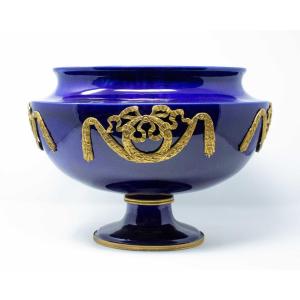Cows
Oil on canvas, cm 57 x 81
With frame, cm 95 x 122
Born in Turbigo, a town in the Ticino valley province of Milan, Carlo Bonomi attended the Brera Academy from 1898 to 1904 and then took part in a series of courses at the Munich Academy of Fine Arts between 1905 and 1907, where he came into contact with the works of the masters Von Stuck and Lembach and where he knew the "popular truth" of the paintings by Kathe Kollwitz. At the beginning of the twentieth century, there was also a formative stay of the artist’s studio in Rome. Returning to Milan after the Roman trip, Bonomi opened a studio in the capital of Lombardy together with Carrà, Castiglioni and Barilli that soon became an important reference point for artists operating in the early twentieth century in the city. He volunteered for the First World War, served in the front lines at Cadore and on Monte Grappa; the war experience strongly marked the artist’s imagination, which, in the works of the second and third decade of the twentieth century, portrays the tragedies and sufferings of soldiers and civilians in war: a crucial example of this trend is provided by The Prisoners of Mauthausen, painted between 1922 and 1923 and presented for the first time at the Exhibition of Expatsfighters of Monza in 1924, where the artist, taking up in an absolutely anti-rhetorical way a work like The martyrdom of the blessed Franciscans in Nagasaki by Tanzio da Varallo at the Pinacoteca di Brera, It perfectly expresses its rebellion and its total distancing from the brutality of the conflict. Bonomi was inspired, especially in the early years of his long career, by late nineteenth century models of the most famous members of the Lombard divisionist circle, first among all Gaetano Previati, Giovanni Segantini and Giuseppe Pellizza da Volpedo, Reinterpreted in a sober and plastic way.An example of this trend is a painting like Sinfonia pastorale: the opera, which takes its inspiration from Le due madri di Segantini by GAM diMilano, retakes the theme of the mother nursing her baby in the heat of the sheep at dawn. Starting from the second half of the '10s of the twentieth century, Bonomi is mainly dedicated to sculpture, which becomes, from this moment on, the most continuous form of his artistic expression. His sculptural works are present in different public places and cemeteries or in private collections, among which we remember: the Monumental Cemetery of Milan or those of Busto Arsizio, Gallarate and Turbigo, as well as the public gardens of Novara. His most famous plasticated work is certainly The Mater: this bronze, made in 1915 and perfected later between 1923 and 1948, represents a woman in the act of in an intense emotional exchange. The work is presented for the first time on the occasion of the First Exhibition of "Novecento Italiano", held at the Permanent Fair of Milan in 1926 and supported and animated by Margherita Sarfatti: In the same year, the sculpture is exhibited at the Dresden exhibition and is purchased by the German government to be placed in the Palace of Ministries in Berlin. This work is made by Bonomi "an absolute sculptor, in which essence and existence coincide, thus framing him among the great sculptors of the twentieth century whose formal integrity is almost unique and finds the perfect balance between painting and sculpture, with the same ideal continuity affirmed by Michelangelo" (V. Sgarbi, Il Novecento, vol. 1, 2018, pp. 158-165). Bonomi is also known for his work as an architect: the restoration operations carried out on his project at the Castle of Turbigo and the Broletto di Novara are well known.
In his copious production, both pictorial and sculptural, the artist never fails to take on some of the traits that distinguish his work: a melancholy resigned but full of pure emotion, an austerity that expresses a pain considered intimate and not theatrical, a laid down humanity, which proceeds by veils and avoids the strong colors, a religiosity of lay nature, focused on the values of human existence.
In this work, probably belonging to the first season of the artist’s production, inspiration to Segantini’s models is evident: Paintings such as Cow at the watering trough of the GAM in Milan or At the stanga of the National Gallery of Modern Art in Rome are an essential starting point for the artist from Turbigo. Compared to the works of Segantini, however, the painting appears more dense and material; it is the artist himself who confirms his clear preference for a painting with a strong material component («I say that the painting seems to me more good, the more it goes towards relief»). Contrary to the vast majority of Bonomi’s works, in this case the colours are particularly bright and the scene, radiated by a brilliant morning light, conveys an atmosphere of calm serenity.
The object is in good condition












































 Le Magazine de PROANTIC
Le Magazine de PROANTIC TRÉSORS Magazine
TRÉSORS Magazine Rivista Artiquariato
Rivista Artiquariato